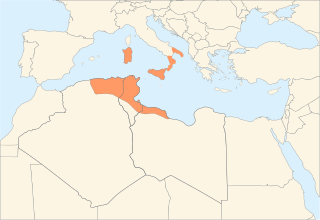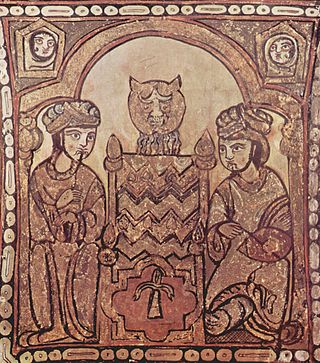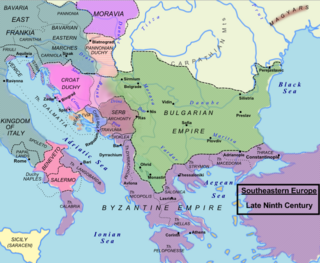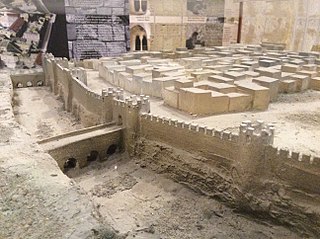Related Research Articles

The Aghlabids were an Arab dynasty centered in Ifriqiya from 800 to 909 that conquered parts of Sicily, Southern Italy, and possibly Sardinia, nominally as vassals of the Abbasid Caliphate. The Aghlabids were from the Najdi tribe of Banu Tamim and adhered to the Mu'tazilite rationalist doctrine within Hanafi Sunni Islam, which they imposed as the state doctrine of Ifriqiya. They ruled until 909 when they were conquered by the new power of the Fatimids.

Butera is an Italian town and a commune in the province of Caltanissetta, in the southern part of the island of Sicily. It is bounded by the comuni of Gela, Licata, Mazzarino, Ravanusa and Riesi. It has a population of 4,653 (2017) and is 49 km (30 mi) from Caltanissetta, the province's capital.

The Kalbids were a Muslim Arab dynasty in the Emirate of Sicily, which ruled from 948 to 1053. They were formally appointed by the Fatimids, but gained, progressively, de facto autonomous rule.

Abu Ishaq Ibrahim II ibn Ahmad was the Emir of Ifriqiya. He ruled from 875 until his abdication in 902. After the demise of his brother, Ibrahim was endorsed as emir where he took steps to improve safety in his domain and secured the development of commercial activities. He improved public works, such as building a vast reservoir, erecting walls as well as the development of mosques and his Raqqada palace.

The Emirate of Sicily or Fatimid Sicily was an Islamic kingdom that ruled the Muslim territories on the island of Sicily between 831 and 1091. Its capital was Palermo, which, during this period, became a major cultural and political center of the Muslim world.
Euphemius or Euphemios was a Byzantine commander in Sicily, who rebelled against the imperial governor in 826 AD, and invited the Aghlabids to aid him, thus beginning the Muslim conquest of Sicily.

The history of Islam in Sicily and southern Italy began with the first Arab settlement in Sicily, at Mazara, which was captured in 827. The subsequent rule of Sicily and Malta started in the 10th century. The Emirate of Sicily lasted from 831 until 1061, and controlled the whole island by 902. Though Sicily was the primary Muslim stronghold in Italy, some temporary footholds, the most substantial of which was the port city of Bari, were established on the mainland peninsula, especially in mainland southern Italy, though Muslim raids, mainly those of Muhammad I ibn al-Aghlab, reached as far north as Naples, Rome and the northern region of Piedmont. The Arab raids were part of a larger struggle for power in Italy and Europe, with Christian Byzantine, Frankish, Norman and local Italian forces also competing for control. Arabs were sometimes sought as allies by various Christian factions against other factions.

The Muslim conquest of Sicily began in June 827 and lasted until 902, when the last major Byzantine stronghold on the island, Taormina, fell. Isolated fortresses remained in Byzantine hands until 965, but the island was henceforth under Muslim rule until conquered in turn by the Normans in the 11th century.
The siege of Syracuse in 827–828 marks the first attempt by the Aghlabids to conquer the city of Syracuse in Sicily, then a Byzantine province. The Aghlabid army had only months before landed on Sicily, ostensibly in support of the rebel Byzantine general Euphemius. After defeating local forces and taking the fortress of Mazara, they marched on Syracuse, which was the capital of the island under Roman and Byzantine rule. The siege lasted through the winter of 827–828 and until summer, during which time the besieging forces suffered greatly from lack of food and an outbreak of an epidemic, which claimed the life of their commander, Asad ibn al-Furat. In the face of Byzantine reinforcements, the new Arab leader, Muhammad ibn Abi'l-Jawari, abandoned the siege and withdrew to the southwestern part of the island, which remained in their hands. From there they pursued the slow conquest of Sicily, which led to the fall of Syracuse after another long siege in 877–878, and culminated in the fall of Taormina in 902.

The siege of Syracuse from 877 to 878 led to the fall of the city of Syracuse, the Byzantine capital of Sicily, to the Aghlabids. The siege lasted from August 877 to 21 May 878 when the city, effectively left without assistance by the central Byzantine government, was sacked by the Aghlabid forces.

The siege of Ragusa by the Aghlabids of Ifriqiya lasted for fifteen months, beginning in 866 until the lifting of the siege at the approach of a Byzantine fleet in 868. The failure of the siege and the re-appearance of the Byzantines in the region of Dalmatia signalled the beginning of new aggressive western policy by the new Byzantine emperor, Basil I. Its immediate effects were the re-establishment of Byzantine authority there in the form of the Theme of Dalmatia, and the beginning of the Christianization of the Slavs of the western Balkans, but within a few years it led to renewed Byzantine involvement and presence in southern Italy as well.

The Battle of the Straits was fought in early 965 between the fleets of the Byzantine Empire and the Fatimid Caliphate in the Straits of Messina. It resulted in a major Fatimid victory, and the final collapse of the attempt of Emperor Nikephoros II Phokas to recover Sicily from the Fatimids.

The siege of Melite was the capture of the Byzantine city of Melite by an invading Aghlabid army in 870 AD. The siege was initially led by Halaf al-Hādim, a renowned engineer, but he was killed and replaced by Sawāda Ibn Muḥammad. The city withstood the siege for some weeks or months, but it ultimately fell to the invaders, and its inhabitants were massacred and the city was sacked.
The siege of Taormina in 962 was a successful siege by the Fatimid governors of Sicily of the main Byzantine fortress on the island, Taormina.
The following is a timeline of the history of the city of Syracuse, Sicily, Italy. Syracuse was the main city of Sicily from 5th century BCE to 878 CE.
The Battle of Caltavuturo was fought in 881 or 882 between the Byzantine Empire and the Aghlabid emirate of Ifriqiya, during the Muslim conquest of Sicily. It was a major Byzantine victory, although it could not reverse the Muslim conquest of Sicily.
The siege of Rometta was a successful siege of the Byzantine city of Rometta, in northeastern Sicily, by the Kalbids on behalf of the Fatimid Dynasty, that took place between 963 and 965 and marked the conclusion of the Muslim conquest of Sicily.
Ahmad ibn Ziyadat Allah ibn Qurhub, commonly known simply as Ibn Qurhub, ruled Sicily in rebellion against the Fatimid Caliphate, from 913 to 916. He launched raids against the Byzantine Empire in southern Italy and against the shores of Fatimid Ifriqiya, but was deposed and handed over to the Fatimids, who executed him and his followers in July 916.

The siege of Salerno was one of the campaigns of the Aghlabids in southern Italy during their conquest of Sicily. The Lombard city of Salerno had strong defences and, despite the use of stone-throwing artillery, the siege lasted a little over a year from its beginning in late 871 or early 872. Prince Guaifer of Salerno led the defence, but the siege was only lifted by the arrival of an army of Lombards and Franks under the Emperor Louis II.

The siege of Taormina in 902 ended the conquest of the Byzantine city of Taormina, in northeastern Sicily, by the Aghlabids. The campaign was led by the deposed Aghlabid emir, Ibrahim II, as a form of armed pilgrimage and holy war. Ibrahim's forces defeated the Byzantine garrison in a hard-fought battle in front of the city walls, and laid siege to the city. Left unsupported by the Byzantine government, Taormina capitulated on 1 August. The population was massacred or sold into slavery. The fall of this last major Byzantine stronghold signalled the completion of the Muslim conquest of Sicily, which had been ongoing since the 820s, although some minor Byzantine outposts survived until the 960s.
References
- ↑ Konstam 2015, p. 15?.
- ↑ Metcalfe 2009, p. 25.